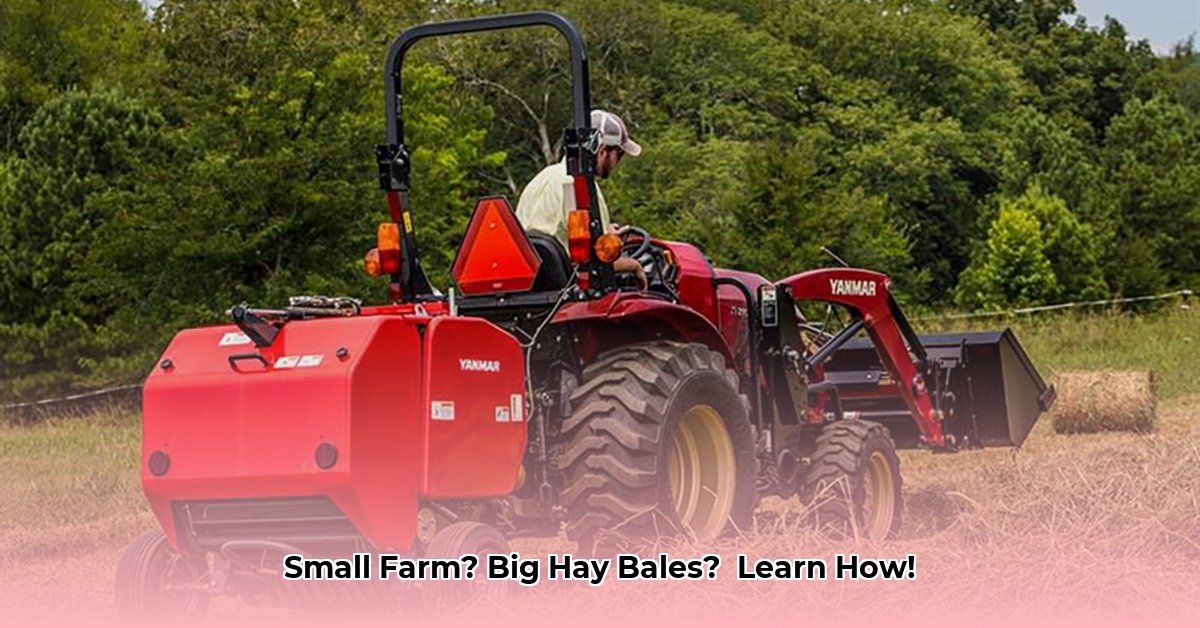
Compact Tractor Hay Baler Systems: A Small Farm Solution
Making hay on a small farm is challenging. Time is limited, and resources are often stretched thin. A compact tractor hay baler system offers a streamlined approach to hay production, increasing efficiency and reducing the burden on small farm operations. This system isn't just about acquiring equipment; it's about implementing a process that maximizes yield and minimizes labor. But is this the right solution for your small farm? Let's explore the details. For more information on rakes, check out this helpful resource: tractor rakes.
How can a compact tractor hay baler system benefit my small farm? This system allows for complete control over your hay production, which translates to greater efficiency and cost savings, ultimately boosting your farm's overall yield.
Understanding the Components of a Compact Hay Baler System
This isn't just a single machine; it's a coordinated system of three key pieces of equipment, all designed to work together seamlessly:
The Mower: A precision mower designed for smaller fields, providing a clean, even cut to optimize hay collection.
The Rake: A specialized rake that gathers the freshly mown hay into neat, manageable windrows, preparing it for baling. This process is vital for maximizing the baler's efficiency.
The Baler: A compact round baler that creates easily-handled, smaller bales ideal for storage and management on smaller farms.
This entire system is designed for tractors with 18 to 30 horsepower and a minimum weight of 1400 lbs. Adequate tractor weight is critical for stability, especially during the baling process.
Evaluating the Advantages and Disadvantages
Before investing, it's crucial to weigh the potential benefits against any drawbacks:
Advantages:
Cost-Effectiveness: Purchasing a complete system can offer significant long-term cost savings compared to hiring custom baling services or piecemeal equipment purchases.
Enhanced Efficiency: The integrated system drastically reduces labor and time required for hay production, freeing up valuable time for other farm tasks.
Sustainability: Smaller equipment generally consumes less fuel and minimizes environmental impact compared to larger systems. It also reduces the need for extensive hay transportation.
Autonomy: Complete control over your hay production schedule, eliminating reliance on external contractors and their schedules.
Disadvantages:
Limited Performance Data: Comprehensive performance data (e.g., bales per hour) can be difficult to find, making direct comparisons between models challenging. This information gap makes decision-making more complex.
Long-Term Durability Concerns: While manufacturers often advertise low maintenance, obtaining detailed information on long-term durability and maintenance costs may require additional research.
Environmental Impact Information Gaps: Independent assessments of the environmental impact throughout the equipment lifecycle are often limited. This underscores the need for greater transparency from manufacturers.
Risk Management: Proactive Planning for Success
Potential risks associated with this system include mechanical breakdowns, wear and tear, and equipment-tractor mismatches. Mitigating these risks necessitates a proactive approach.
| Component | Potential Problem | Likelihood | Impact | Mitigation Strategy |
|---|---|---|---|---|
| Baler | Mechanical Failure | Medium | High | Regular maintenance, operator training, spare parts inventory |
| Mower | Blade Damage/Wear | Medium | Medium | Regular sharpening, careful operation |
| Rake | Structural Failure | Low | Medium | Regular inspections for damage |
| Entire System | Tractor Horsepower Mismatch | Medium | High | Precise matching of tractor specifications to equipment needs |
| Entire System | Scalability Issues | Low | Medium | Future expansion planning, consideration of upgrade options |
Actionable Steps for Choosing and Implementing Your System
Choosing the right compact tractor hay baler system requires careful planning:
Conduct Thorough Research: Compare brands, models, specifications, and user reviews. Remember that manufacturer claims may be overly optimistic.
Request Demonstrations: If possible, observe or participate in equipment demonstrations to gain hands-on experience.
Consult with Experienced Farmers: Seek advice from fellow farmers who use similar systems. Their first-hand experience provides invaluable insights.
Maintain Continuous Awareness: Stay informed about the latest advancements and research in sustainable hay-making technologies and equipment.
Choosing a compact tractor hay baler system is a significant investment. A well-informed decision, paired with proactive planning and diligent maintenance, maximizes the chances of a successful and profitable hay production process. It's about building a system that supports your farm's long-term sustainability and growth.